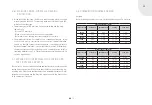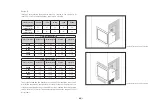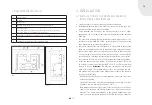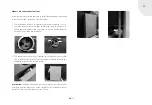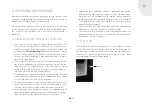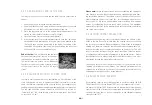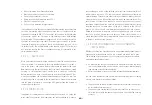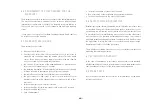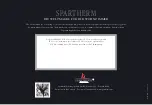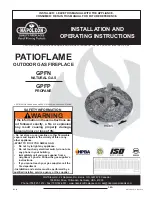
GB
GB
27
The nominal heating capacity of the individual fireplace cassettes when
operated as a temporary heating source (meaning with operative intervals of
less than 8 hours) provides the following room heating capacities:
Fireplace
cassette
500
600
700
800
900
D4
E4
D5
E5
D6
E7
D8
E10
D11
E14
NHC in KW
4,0
4,6
4,9
4,9
5,9
6,9
7,9
9,9
10,5
14,0
Heating condition
Room heating capacity* during temporary heating (values in m³)
favourable
88
88
88
88
124
165
186
>186 >186 >186
less favourable
53
53
53
53
73
95
107
132
145
>173
unfavourable
34
34
34
34
48
65
73
90
98
>114
* Significantly larger rooms can be heated with modern thermal insulation.
A more precise description for “favourable”, “less favourable” and “unfa-
vourable” can be found in the DIN 18893 standard. In simple terms, “favour-
able” represents a situation in which the room only has one exterior wall and
is otherwise surrounded by heated interior rooms, “unfavourable” means, in
contrast, rooms with two exterior walls and adjacent unheated rooms.
The values given above refer to building structures that do not yet cor-
respond to the requirements of the thermal insulation standards from 1977
and also represent, therefore, a simplified process that is only valid up to
a maximum room size of 200 m³. The DIN 18893 standard already recom-
mends using DIN 4701 for these calculations from a room size of 200 m³.
It is now preferable to make an estimate according to TROL or, in particular,
to make a calculation according to DIN 12831.
5.7 HEATING IN THE TRANSITIONAL PERIOD / UNFA-
VOURABLE WEATHER CONDITIONS
In the transitional period, meaning when the outside temperature is still high
(above approx. 15°C) or during unfavourable weather conditions (katabatic
winds etc.), it is possible to experience disruption to the chimney flue per-
formance during sudden rises in temperature so that the hot gasses are not
completely extracted. In these circumstances, the fireplace should only be
filled with a low volume of fuel and the air damper operated at its highest
setting. This will result in the existing fuel burning quicker (with a greater
development of flames). As a result, the performance of the chimney flue
should stabilise. In order to avoid resistance in the bed of embers, the ash
should be carefully taken off at regular intervals. After the chimney has
stabilised, the air intake feed can be reduced a little (to around the medium
setting).
5.8 FUEL
The foundation “Wald in Not” (Forest in Danger) put it aptly in one of their
information brochures: “Wood does not cause any burden for nature. Wood
is stored energy from the sun. Sunlight, water and carbon dioxide are the
building blocks from which wood is created. Sunlight is chemically bonded
during the whole life of the tree. The sun’s energy is stored in lignin and
cellulose. This energy is set free again when the wood is burnt! You can
find out more information on the internet site www.wald-in-not.de. Fire-
places may only be operated using fuels that correspond to the 1st BlmSchV
regulations. Only firewood (recommended residual moisture 20% or less) or
wood briquettes according to DIN 51731 are permissible for use in fireplace
cassettes.
No other type of fuel may be used!
Therefore, it is not permissible to burn the following:
• Varnished or plastic-coated wood
• Chipboard or wood that has been treated with wood preservative
Summary of Contents for L 800
Page 1: ...GB Installation and Operating Instructions Linear Fireplace Cassettes...
Page 34: ...GB 34 NOTES...
Page 35: ...GB GB GB 35...

